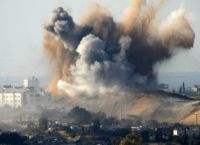Middle East/Gaza
Israel used white phosphorous in Gaza offensive, says Human Rights Watch report
Article published on the 2009-03-26 Latest update 2009-03-26 15:06 TU
The Human Rights Watch report provides witness accounts of the "repeated" use of the chemical and its "devastating effects".
International treaties ban the use of white phosphorus in areas where civilians are concentrated, although its used to hide military action away from civilians is allowed. HRW says that Israel repeatedly used it in densely populated areas and that the report provides "evidence of war crimes".
Israel's armed forces, who denied using white phosphorous when the charges first surfaced, said Thursday that an internal enquiry has shown that it was used "in accord with international humanitarian law".
HRW says that the use "must have required the approval of senior military officers".
"Human Rights Watch researchers in Gaza, immediately after hostilities ended, found spent shells, canister liners, and dozens of burnt felt wedges containing white phosphorus on city streets, apartment roofs, residential courtyards, and at a United Nations school," the organisation says.
The Israel army statement says "contrary to the claims in the report, smoke shells are not an incendiary weapon."
"The third protocol of the Convention on Certain Conventional Weapons, which defines particular limitations on incendiary weapons, makes it clear that weapons intended for screening are not classed as incendiary weapons."
It adds that Israel is not a signatory to the third protocol.
The evidence is incontrovertible, according to Bill Van Esveld of Human Rights Watch.
Researchers found spent shells, which showed that they were made by US companies, Van Esveld told RFI.
"Most of the shells we found were made in the United States in 1989, in Louisiana, by Thiokol Aerospace, a defence company. Other pictures were shown by the media of shells that were manufactured in 1991 in Pine Bluffs, Arkansas."
Q+A: Bill Van Esveld of Human Rights Watch
HRW also says that it found no evidence of Israeli claims that Hamas, which controls the Gaza Strip, used civilians as human shields.
In February Amnesty International called for an arms embargo on Israel over the issue.
Since the end of the conflict, several other NGOs have issued reports of alleged war crimes.
Middle East - interview
International complicity helps Israeli "war crimes" in Gaza, says Barghouti
2009-01-26 10:04 TU













